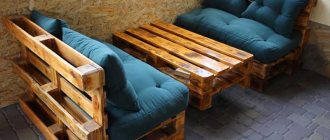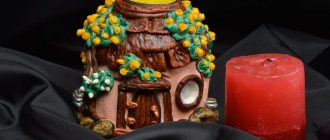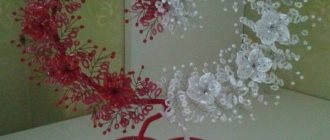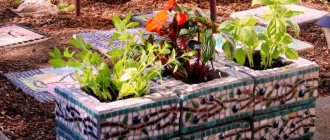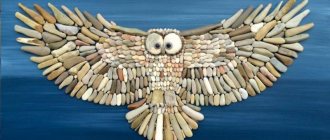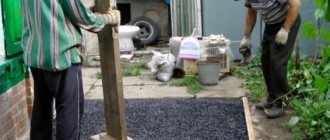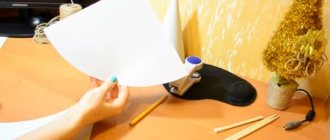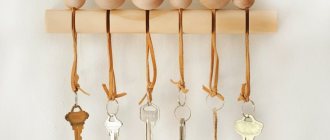Benefits of working independently
You can buy a finished beautiful product in any upholstered furniture store, but to make it from felt or silk - this will require time and effort. However, a hand-made ottoman will be an excellent reminder of the work done. In addition, the master can choose absolutely any color combination and decorate the product with any materials and texture.
Today, there are a huge number of models of homemade ottomans: soft in the shape of a bag or hard frame options, from a large plastic bottle or from an old stool. Let's consider the most current and original models.
Create a soft ottoman-bag
To work, you need to prepare the following materials:
- Fabric for outer cover.
- Fabric base for the inner bag.
- Filler.
- Decorative elements (ribbons, guipure).
- Pattern.
If the master has a sufficient level of cutting and sewing skills, you can make the template yourself. In another case, patterns of finished models are available on the Internet for studying and downloading.
Step-by-step instructions for the master:
- Using the prepared patterns, we cut out a fabric blank for the inner cover: the outer bag should be larger in volume than the inner cover.
- The inner cover is stuffed with soft filling.
- The outer bag is sewn according to a different principle. Eight parts are made using the templates: two rounded parts for the base and top, six wedge-shaped parts for the sides. This principle of creating elements will allow you to give the pouf a certain shape.
- The wedges are sewn together and with the lower part.
- An inner cover filled with filler is placed inside the formed frame-bag.
- Lastly, the upper rounded element of the pouf is sewn on.
- Be sure to sew in a zipper so that you can remove the outer cover for washing in the future.
The original ottoman is ready for practical use.
Pear ottoman option
Let's look at how to make an ottoman bag, which is a fashionable element of modern interiors.
You will need:
- Pattern paper;
- Fabric for the inner cover – 300x150 mm;
- Threads of high density;
- Strong and dense fabric for upholstery (suede, tapestry) – 320x150 mm;
- Zipper – 60 cm;
- Polystyrene foam filler with holofiber additive - 0.5-1 cubic meters. meter.
For the inner cover of the product, choose a slippery, smooth fabric. Thanks to it, the filler will easily roll over the bag and take the shape of the person resting in it.
The pouf pattern contains six bag wedges and one bottom piece for the base.
- First, drawings of the necessary parts must be made on paper. Next, they are transferred to the fabric that will be used on the outer and inner parts of the ottoman;
- When cutting, leave seam allowances of 1.5 cm;
- The upholstery bag should be made up of pieces that are slightly larger in size than the filler pieces, so the outer cover will be easier to fit onto the filler bag;
- We sew all the fabric parts of the bag. First, these will be wedges that are sewn together, then we proceed to the base;
- Leave room for the zipper on the outside;
- We pour filler into the inner bag, which will take up 2/3 of its volume, and stitch the remaining places;
- We put the cover on top and fasten the zipper.
A cute pear ottoman will add comfort and coziness to your home.
Hard frame pouf
For work you will need the following materials and a set of tools:
- Sheets of plywood or chipboard, several wooden blocks.
- Soft fabric for upholstery.
- Filler.
- Threads, needles, scissors.
- Screws.
To make a hard ottoman, you can use the following step-by-step instructions:
- First of all, prepare the frame. Two parts are cut out of chipboard for the base and top, as well as a long sheet to form the side.
- Wooden blocks are screwed onto the lower workpiece, and the frame cover is attached to the top.
- A flexible sheet of thinner chipboard is attached to the outer surface of the base, sequentially screwing the material to the bars with screws.
- Now you need to make soft upholstery.
- Blanks of the appropriate size are cut from the fabric base.
- A bag for the frame with a zipper running along the bottom of the pouf is sewn from some of the blanks.
- But the pouf cannot be left without a soft seat. Therefore, we separately prepare two fabric circles according to patterns: one should be larger in diameter.
- The circles are sewn together to form a kind of bag that needs to be filled with filler. To decorate, the circle is stitched with strong threads, making mesh-shaped seams.
- By slightly pulling the seam threads, we will give the pillow an interesting hilly look.
All that remains is to hem the pillow onto the top edge of the fabric cover.
Chipboard ottoman cover
To perform finishing work you will need the following tools and materials:
- decorative fabric for upholstery;
- a piece of padding polyester or foam rubber;
- furniture stapler;
- glue gun;
- sewing machine.
Choice of upholstery fabric
First, you need to choose what stylistic solution your new upholstered chair will have. Depending on the style, I cover the ottomans with various dense texture fabrics - tapestry, suede, velor, velvet, eco leather, eco fur and other materials.
For example, a pouf covered with satin or brocade-like fabric is perfect for a classic design.
If you are planning to decorate a room in an ethno style, then a matting pouf will look very good in it.
Modern interior styles will perfectly complement original pieces of furniture made in patchwork style.
To make such a cover, you will need several scraps of dense fabric of contrasting colors, from which you should cut out identical wedges and sew them together. You will get a very bright and stylish seat for the ottoman. The sides of the chair cover can be cut from a plain fabric that matches the color tone of one of the patches.
Stages of work
Take your old ottoman or make a frame for the ottoman from sheets of chipboard or plywood. In accordance with its dimensions, make patterns from the prepared fabric.
We cut out a piece of foam rubber according to the size of the seat.
Next, you need to measure and sum the width of all sides of the pouf. Based on the measurements obtained, taking into account the height of the product, we cut out a piece of padding polyester and cover the side parts with it. We secure the padding polyester using a furniture stapler.
To make this work easier, you can first apply special glue to the walls of the pouf frame. In the same way, secure the foam rubber blank to the seat of the chair. Attach the patterns cut from upholstery fabric with a stapler to a soft base, tucking the edges.
At the junctions of the parts, glue a suitable decorative cord or apply a decorative pattern to the sides.
Another way to update an ottoman with your own hands is to sew a cover from the selected material. This option will be more practical, since if necessary, it can be removed, washed and put back on the pouf.
To do this, fabric patterns must be basted together and stitched on a sewing machine.
After we sew all the parts together, we need to cut off the excess fabric and smooth the seams with an iron.
The bottom edge must be hemmed by machine or by hand and also ironed. We turn the cover inside out and put it on the pouf, straightening out the folds.
At this point, the work on the updated pouf is not completely finished - if desired, it can be decorated. For example, you can sew a large button into the middle of a seat made of scraps, having previously covered it with decorative material in the color of the sides.
An ottoman trimmed with ruffles or lace is perfect for a girl’s bedroom or children’s room.
A fringe sewn on the bottom will look good on a product intended for an interior in a baroque or classic style.
Ottoman from an old stool
If there is an old stool left somewhere in the closet, do not rashly throw it away: the stool will work perfectly as a frame for a pouf. The materials for the work will be approximately the same as in the previous method. To work, use the following instructions:
- Remove the seat from the stool.
- Fasten the grosgrain ribbon over the resulting opening, placing the stripes crosswise.
- Paint the legs of the stool in bright colors. You can additionally apply several layers of clear acrylic varnish to add a glossy shine.
- Wrap a layer of foam rubber around the legs and attach it with screws to a solid underlying base.
- The seat of such an original ottoman can be made from foam rubber, a fabric pillow, or a wicker cover with filling.
An interesting model for your home
Ottoman made from a plastic bottle
A similar model can be made from a durable 19-liter drinking water bottle. This pouf is perfect for a child's room. To work you will need to prepare:
- A 19 liter bottle and 4 1.5 liter bottles.
- Scissors.
- Glue.
- Fabric blanks.
Next, we will use the following instructions for creating a children's toilet seat:
- You need to cut off the neck of a large plastic bottle.
- Glue four plastic bottles to the inner surface of the workpiece (they act as support structures).
- All that remains is to wrap the frame with fabric using glue.
Use brightly colored fabric, as the pouf is intended for a child's room.
The most unusual ideas for ottomans
One has only to look at the various design ideas, and there is something to be surprised by. The variety of designs, styles and textures is amazing. Let's look at the most unusual models of handmade poufs.
Pouf from an old car inner tube
After washing and sealing holes (if any), the car inner tube is wrapped in a layer of padding polyester, gluing the material to the rubber. A fabric cover with a zipper is formed over the soft upholstery so that the fabric can be removed for washing. You can also place a filler wrapped in a small case in the inner space of the circle.
Poufs from old logs for the terrace
A great idea for a summer terrace or gazebo. You will first need to hygienically treat the deck: impregnate the wood with an antiseptic solution, antipyretic and antifungal agent. A fabric pillow is prepared according to the size of the upper platform of the old stump: you need to prepare two blanks, sew them and stuff them with synthetic padding. The pillow is secured with screws or strong glue.
There are a lot of ideas for creating interesting ottomans: from old boxes, cable reels, a bunch of durable bottles. If desired, you can make internal storage for magazines, old toys or other small items. Photos with step-by-step instructions, which can be easily found in any practical needlework magazine, will help you choose a pouf model and work technique.
Choosing the design and shape of the ottoman
The design of the pouf depends on the interior of the hallway. It should match the rest of the furnishings in color and be the right size. If necessary, the pouf can perform several functions, depending on the chosen model.
Crafting and decorating your home with your own hands is a rewarding experience.
Color
It is better to make the pouffe box the same color as the rest of the furniture in the hallway. The lid can be contrasting, but you need to think about what it could be combined with. Rooms where the legs of the pouf and, for example, the mirror frame are painted in the same shade look interesting. A plain ottoman in the color of the door, walls or floor also looks stylish.
Gray color is very stylish.
If the style of the apartment allows, the pouf can be given a place as a bright accent. In this case, it may not be combined with other pieces of furniture. This solution fits into modern design projects.
With lid and shoe rack
One of the most convenient models is a pouffe with a lid and a shoe stand. The upper part can be made soft or left without a seat; you can sit on it or put a bag on it.
An ottoman with a lid is functional.
Under the lid there is enough space for a minimum set of shoes. You don’t have to buy a separate stand, leaving room for a closet or chest of drawers.
Other models
The simplest and most popular form of pouf is a box. This model is easy to make, has space for storage inside, and does not take up much space. There are corner ottomans, they help save space in the hallway, since the corners usually remain unused.
The pouf cabinet is indispensable in the hallway.
A pouf cabinet is another option for optimal use of space. In this model, the seat is attached to a storage system with drawers or hinged doors. Round and cylindrical poufs also have a hinged lid so that you can put some things inside.
Round pouffe boxes are used for storing things.
If desired, the pouf can be upholstered with soft material or left without a decorative covering. When making such a choice, you need to start from the interior of the hallway.
